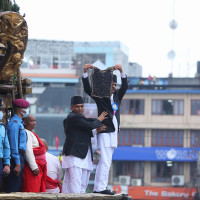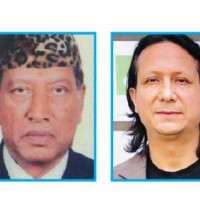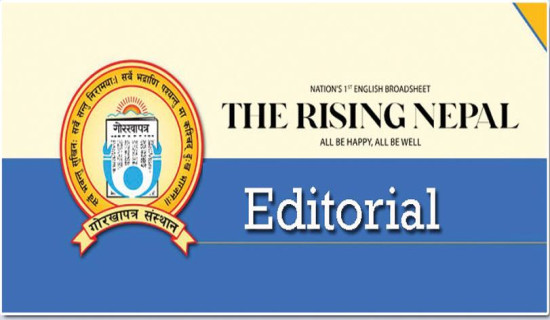- Sunday, 1 June 2025
Innovation Takes Root In Desert
The Gulf refers to the Gulf countries bordering the Persian Gulf. These include Bahrain, Kuwait, Iraq, Oman, Qatar, Saudi Arabia, and the United Arab Emirates. The Gulf always seemed hot, harsh, and arid to me. Nepali migrant workers travel there for employment opportunities, primarily in '3D' sectors – dirty, dangerous, and demeaning jobs. The Gulf is a significant employment destination for Nepalis, as remittances they send play a crucial role in supporting the country's economy.
My friend, Ram Bahadur Chhetri, who has been living and working in the Gulf for over a decade as the GCC coordinator of Global IME Bank Limited, had long invited me to visit the Gulf. Until then, I had very little interest and had avoided it with various excuses. However, only when Qatar hosted the World Cup did the Gulf receive international attention. I, too, started following the news and learned about some of the changes there. That helped me to kindle my willingness to visit the Gulf.
Last October, I had the opportunity to visit Qatar, Saudi Arabia, Bahrain, and the UAE. But to my surprise, I found how even the most arid deserts had been transformed and were blooming with new prosperity.
The stories shared by friends in the region were even more fascinating, including those about urban planning, agricultural growth, and technological advances. One of my friends, Nayan Ghimire, hosted us in Qatar. He has been living there for over a decade. He works at an agri-industry that was established after the economic blockade in Qatar. He shared many more amazing stories about Gulf's progress in recent years. From the glittering cityscapes to the green spaces growing in the desert, I was amazed. My journey, which covered over 3,500 kilometers by road and included visits to cities like Doha, Riyadh, Dammam, Manama, Dubai, and Abu Dhabi, was more than just an exploration of places; it was a journey through ideas reshaping the Gulf.
Employment
Over the past decade, the Gulf countries have made significant strides in diversifying their economies. Historically reliant on oil and gas, the Gulf countries have expanded into finance, tourism, healthcare, and technology sectors. As a result, quality of life has improved, with quality education, healthcare, and infrastructure. The GDP growth has been robust, and per capita income remains among the highest in the world.
Similarly, the employment landscape has also evolved. Construction, finance, healthcare, technology, real estate, and tourism have flourished, creating millions of jobs. The Gulf countries are generating employment for 30-35 million foreign workers. Nepali migrant workers make up a notable portion of this labor force, with 1.5 to 2 million Nepali migrant workers in the region.
The Gulf region's rapid growth has spurred major urban development, attracting foreign investment and multinational companies. This has lead to economic diversification in areas like renewable energy, digital technology, and finance, and generating new jobs.
Smart growth
Qatar is one of the smallest countries in the Gulf, but its transformation was immediately evident upon arrival. A few years ago, Qatar faced an economic blockade by the neighboring countries. During the embargo, which lasted for more than four years, Qatar adopted state-of-the-art techniques in agriculture and farming. They adopted the methods like hydroponics and vertical farming to grow crops. Qatar's significant advancements in farming and agriculture have substantially reduced its reliance on imported food and agri-products. Once entirely dependent on food and agri-products, it produces cereals, dairy products, vegetables, and fruits. While driving across different cities in Saudi Arabia, Chhetri, who accompanied us, shared many amazing stories of the strides made by the country over the past decade.
The Gulf countries are creating models for future development. Whether through renewable energy or new agriculture and urban planning technology, the Gulf shows the world what is possible when vision and technology come together.
The UAE, in particular, is a leader in renewable energy. The Mohammed bin Rashid Al Maktoum Solar Park in Dubai is one of the largest in the world, providing clean energy to thousands of homes, offices, and businesses. The UAE also builds smart cities where artificial intelligence and data optimize traffic flow and water management. It is a model for the world to follow.
Saudi Arabia's Vision 2030 is another excellent example of transformation. From big solar projects to water conservation and green building design efforts, Saudi Arabia is moving toward a future where its economy does not rely solely on oil and gas. This shift is happening now. The Gulf is becoming smarter with new projects focused on innovation, technology, and environmental responsibility.
Qatar is also pushing for sustainability. All its urban planning and energy policies are environment-friendly. The Pearl-Qatar, an artificial island in Doha, shows how development and sustainability can go hand in hand. The successful hosting of the FIFA World Cup 2022 highlighted its ability to balance big development with sustainability.
In Bahrain, crossing the 25-kilometre-long King Fahd Causeway was an adventure. How did they build such a long bridge over the sea? This engineering wonder connects Saudi Arabia to Bahrain, offering stunning sea views. The long bridge over the sea left me in awe.
Diversification
The Gulf region, once known for its deserts and oil, is experiencing significant advancements and creating new opportunities. The green revolution, powered by advances in agriculture and the glowing cities built on sustainable practices, paints a picture of a promising future. From solar-powered greenhouses in the UAE to bright lighting in Riyadh, the Gulf proves that even the most demanding environments can become thriving innovation centers.
As I returned from this trip, I carried memories of high skyscrapers, vast and beautiful roads, state-of-the-art buildings, shining cities, and green deserts and a deep sense of optimism. I realised 'nothing is impossible'.
The oil-rich countries have diversified their economy into multiple sectors. The Gulf is not only dependent on oil now. The sectors such as agriculture, tourism, real estate, finance, technology, and many more are booming. The Gulf is going green and glittering, promising a future where everything is possible.
(Pokharel writes on business, economy, and development issues.)















